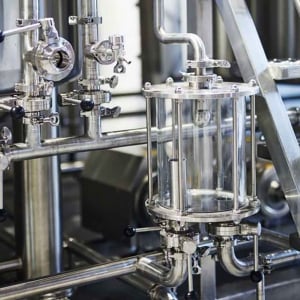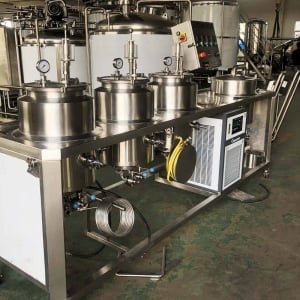The Ultimate Guide to Fermenter Tanks
Overview: Understanding Fermenter Tanks
Fermenter tanks play a crucial role in industries such as brewing, winemaking, and biofuel production. These tanks provide a controlled environment for the fermentation process, turning raw materials like sugars and starches into desired products like alcohol or biofuels. Choosing the right fermenter tank can be the difference between a smooth, efficient process and costly setbacks.
This guide covers everything from the basics of fermenter tanks to detailed equipment guides, comparisons, and maintenance tips. By the end, you’ll have a clear understanding of the best options available and how to navigate this essential piece of equipment for your operations.

Key Aspects to Consider in Fermenter Tanks
| Aspect | Description |
|---|---|
| Tank Capacity | Capacity can range from a few liters for home brewing to thousands of liters for commercial production. |
| Material | Stainless steel is standard due to durability, but some use glass or plastic for specific applications. |
| Temperature Control | Essential for consistent fermentation; tanks can include cooling jackets or external chillers. |
| Design and Shape | Cylindroconical designs are popular for efficient yeast collection and cleaning. |
| Sealing and Pressure | Tanks can be sealed for anaerobic fermentation or left open, depending on the application. |
Types of Fermenter Tanks
| Type | Characteristics |
|---|---|
| Open-top Fermenters | Primarily used for specific ales, allowing yeast and other organisms to interact with the environment. |
| Closed Fermenters | Provide a sealed environment, controlling oxygen exposure and preserving flavors. |
| Cylindroconical Tanks | Most common in breweries, these have a conical base for efficient yeast harvesting and cleaning. |
| Horizontal Tanks | Used for lagering, providing increased surface area for certain fermentation needs. |
| Jacketed Fermenters | These tanks include built-in cooling or heating systems to manage fermentation temperature. |
Detailed Brewing Process in Fermenter Tanks
The fermentation process starts with selecting the correct tank type and preparing the wort (in beer brewing) or must (in winemaking). Once transferred into the tank, yeast is added to start fermentation. Here’s a breakdown of the process:
- Preparation and Filling: The raw material is prepared and sterilized, reducing contamination risks.
- Pitching the Yeast: Yeast is added based on the specific type of fermentation—top or bottom fermentation.
- Active Fermentation: Temperature, pressure, and other conditions are controlled for optimal yeast activity.
- Secondary Fermentation (Conditioning): Some tanks allow for secondary fermentation, which enhances flavor.
- Cleaning and Reusing Tanks: Post-fermentation, tanks are sanitized to ensure the longevity of equipment and product quality.
Capacity, Space, Design, and Customization
| Factor | Explanation |
|---|---|
| Capacity | Larger tanks allow for more production but may require more space and infrastructure investment. |
| Space and Layout | Tanks must fit within a designated space, considering accessibility for cleaning and maintenance. |
| Design | Conical, cylindrical, and custom shapes affect both function and appearance in a production facility. |
| Customization Options | Custom features like built-in cooling coils or extra ports can enhance functionality for specific uses. |
Fermenter Tank Suppliers and Price Range
| Supplier | Price Range (USD) | Key Features |
|---|---|---|
| ABC Brewing Supplies | $5,000 – $20,000 | Offers customized fermenters with heating and cooling options for large breweries. |
| BrewTech Innovations | $3,000 – $15,000 | Known for durability and easy maintenance designs suitable for medium breweries. |
| HomeBrewer’s Source | $200 – $2,000 | Budget-friendly options for home brewers, including smaller stainless steel tanks. |
| MegaVats Inc. | $7,000 – $25,000 | Specializes in high-capacity, automated fermenters for large-scale operations. |
Installation, Operation, and Maintenance of Fermenter Tanks
| Step | Details |
|---|---|
| Installation | Ensuring the tank is set up in a temperature-controlled, accessible area with adequate ventilation. |
| Operation | Adjust settings according to fermentation needs—temperature, pressure, oxygen levels as required. |
| Maintenance | Routine cleaning with sanitizing agents prevents contamination and extends the tank’s operational life. |
| Repairs | Regular checks for leaks, loose fittings, or damage, and quick repair to avoid disrupting production. |
Choosing a Fermenter Tank Supplier
| Factor | What to Look For |
|---|---|
| Reputation | Reviews and feedback from previous clients for quality assurance. |
| Customization Options | Ability to meet specific needs, like size, cooling, or pressure handling capabilities. |
| After-sales Support | Strong support helps with setup, maintenance advice, and troubleshooting issues. |
| Delivery and Installation Services | Suppliers that handle delivery and setup can save significant time and effort. |
| Warranty | Long warranties indicate confidence in product durability and quality. |
Comparing Pros and Cons of Fermenter Tanks
| Feature | Advantages | Limitations |
|---|---|---|
| Stainless Steel | Durable, easy to clean, resistant to rust | Can be expensive, heavy to move |
| Glass Fermenters | Transparent, good for monitoring | Fragile, typically only available in smaller sizes |
| Plastic Fermenters | Lightweight, affordable | Prone to scratches, harder to sanitize |
| Jacketed Fermenters | Precise temperature control | Higher cost, requires more complex setup |
| Open-top Fermenters | Allows natural yeast exposure | Limited to specific types of fermentation like ales |

FAQs
| Question | Answer |
|---|---|
| What is the best material for fermenter tanks? | Stainless steel is most popular for its durability and ease of cleaning, though glass and plastic have niche applications. |
| How does temperature control work in fermenters? | Many tanks have jackets that allow glycol to circulate, keeping the fermentation at optimal temperatures. |
| What size fermenter tank should I choose? | This depends on your production volume. For home brewing, a 5-gallon tank suffices, while commercial setups may need multiple 1,000-gallon tanks. |
| How often should I clean a fermenter tank? | Tanks should be cleaned and sanitized after every use to prevent contamination. |
| Are fermenter tanks expensive to maintain? | Routine maintenance is low-cost, though repairs can be pricier if tanks aren’t regularly checked and cleaned. |













